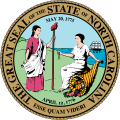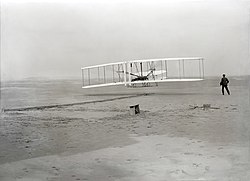North Carolina
North Carolina is one of the 50 states of the United States. The capital of North Carolina is Raleigh and the city with the most people is Charlotte. North Carolina is split into 100 counties, and each county has many cities and towns.
| The State of North Carolina | |
|
| |
|
| |
| Anthem: The Old North State | |
 Map of the United States with North Carolina highlighted | |
| Country | United States |
| Before statehood | Province of North-Carolina |
| Admitted to the Union | November 21, 1789 (12th) |
| Capital | Raleigh |
| Largest city | Charlotte |
| Largest metro | Greater Charlotte |
| Government | |
| • Governor | Josh Stein (D) |
| • Lieutenant Governor | Rachel Hunt (D) |
| Legislature | General Assembly |
| • Upper house | Senate |
| • Lower house | House of Representatives |
| U.S. senators | Thom Tillis (R) Ted Budd (R) |
| U.S. House delegation |
|
| Area | |
| • Total | 53,819 sq mi (139,390 km2) |
| • Land | 48,711 sq mi (126,161 km2) |
| • Water | 1,972 sq mi (5,108 km2) 9.5% |
| • Rank | 28th |
| Elevation | 700 ft (210 m) |
| Highest elevation | 6,684 ft (2,037 m) |
| Lowest elevation (Atlantic Ocean[3]) | 0 ft (0 m) |
| Population (2019) | |
| • Total | 10,488,084 |
| • Rank | 9th |
| • Density | 208.7/sq mi (80.6/km2) |
| • Rank | 15th |
| • Median household income | $52,752[5] |
| • Income rank | 39th |
| Language | |
| • Official language | English[6] |
| • Spoken language | As of 2010[7]
|
| Time zone | UTC−05:00 (Eastern) |
| • Summer (DST) | UTC−04:00 (EDT) |
| USPS abbreviation | NC |
| ISO 3166 code | US-NC |
| Trad. abbreviation | N.C. |
| Latitude | 33° 50′ N to 36° 35′ N |
| Longitude | 75° 28′ W to 84° 19′ W |
| Website | www |
| North Carolina state symbols | |
|---|---|
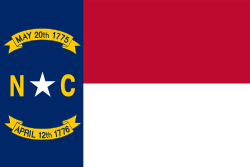 | |
 | |
| Living insignia | |
| Bird | Cardinal |
| Butterfly | Eastern tiger swallowtail |
| Fish | Red Drum |
| Flower | Flowering Dogwood |
| Insect | Western honeybee |
| Marsupial | Virginia Opossum (state marsupial) |
| Tree | Longleaf Pine |
| Inanimate insignia | |
| Beverage | Milk |
| Dance | Clogging |
| Food | Scuppernong grape, sweet potato |
| Fossil | Megalodon teeth |
| Gemstone | Emerald |
| Mineral | Gold |
| Rock | Granite |
| State route marker | |
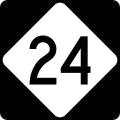 | |
| State quarter | |
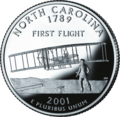 Released in 2001 | |
| Lists of United States state symbols | |
North Carolina was one of the original thirteen colonies and was where the first English colony in America lived. As of 2024, there were about 10,400,000 people living in the state.[8]
In 2018, North Carolina was number one on Forbes' Best States for Business list for the second year in a row.[source?]
History
The Beginning
Before the English came, about 30 Native American groups lived in what is now known as North Carolina. In 1584, Sir Walter Raleigh started two colonies, but they did not last long. One of these, the Roanoke Colony, later became known as the Lost Colony and is still known as one of the great unsolved mysteries of early American history to this day. Virginia Dare, the first English child born in America, was born in the Roanoke Colony.
The first permanent settlers in North Carolina came from the state of Virginia in 1655 because there was not enough farmland in Virginia.[9] Later the land was cut up into present-day North Carolina and South Carolina. The name "Carolina" comes from the Latin for Charles (Carolus) after King Charles I.
The Seaborne Slave Trade of North Carolina from the North Carolina Historical Review reports that slaves brought to North Carolina before the Revolution came from the West Indies: Montego Bay, Jamaica; Barbados; Antigua; and the Bahamas; a small number from mainland colonies; and an even smaller number directly from Africa, though less than 150 slaves were imported every year between 1772 and 1775.
The economy's growth and prosperity was based on slave labor. Early on, tobacco was an important source of money.
The American Revolutionary War
North Carolina was an important state during the American Revolutionary War. In April 1776, North Carolina passed the Halifax Resolves. The state was the first to vote in favor for independence from Great Britain.[10] This act led to the Declaration of Independence being adopted three months later.[11] After this, North Carolina was the site of many battles in the Revolutionary War, such as the Battle of Guilford Courthouse.[12] Even though they were the first state to call for independence, they were one of the last to adopt the US Constitution.[13] This is because many North Carolinians did not like the many new powers that the Constitution gave to the federal government.[14]
The Civil War
In 1860, North Carolina was a slave state. About 1/3 of the people in the state were slaves. North Carolina fought as part of the Confederacy during the Civil War, but it was the last state to leave the Union. The state sent about 125,000 troops to fight in the war and about 40,000 of them died. Even during the war some people in North Carolina did not support the Confederacy, mostly because the Confederacy believed in slavery. The people who did not support the Confederacy were called Unionists. The first Confederate soldier to be killed was from North Carolina.
Geography
North Carolina touches South Carolina on the south, Georgia on the southwest, Tennessee on the west, Virginia on the north, and the Atlantic Ocean on the east. The state is divided into three main areas of land, the Coastal Plains to the east, the Piedmont region in the middle, and the mountain ranges of Appalachia to the west. The eastern coast of the state is lined with a string of barrier islands known as The Outer Banks.
North Carolina is known for its changing weather across the different regions of the state.
Coastal Plain (East North Carolina)
The eastern part of the state touches the Atlantic Ocean, and usually has moderate temperatures all year long, usually not above 90 °F in the summer and not under 40 °F in the winter. However, it can get hotter than 100 °F and as cold as 20 °F. Most years there is less than one inch of snow and some years go by with no snow at all. The coastal plain usually gets a tropical storm every 3 or 4 years.
Piedmont (Middle North Carolina)
The average temperature normally does not go above 90 °F in most parts of the Piedmont in summer, but can go over 100 °F when there is a heat wave. Ice pellets and freezing rain are normal in this part of North Carolina, but the mountains protect the Piedmont from the worst winter weather. Snow in this region rarely lasts more than 48 hours before melting. Weak tornadoes are often seen in the Piedmont, but only 140 people have died by tornadoes from 1950 to 2012 in the entire state.
Mountains (West North Carolina)
The average temperature almost never goes above 80 °F in the summer and is usually in the high 30’s or low 40’s in the winter in the mountain region of North Carolina. About 14 to 20 inches of snow fall each year with some of the higher elevations getting 50 inches each winter. The wettest part of the mountains gets 90 inches of rain.[15]
Politics
Until recently, North Carolina mostly voted for Democrats. In presidential elections, it has voted Democratic twice as many times as it has voted Republican. In presidential elections from 1968 to 2004, North Carolina supported the Democrat only in 1976, when he came from the South. However, from presidential elections from the century of 1868 to 1964, North Carolina voted for the Democrat in all 25 elections except for 1928. The state's governor, Roy Cooper, is a Democrat.[16]
Major cities
The largest city in North Carolina is Charlotte, North Carolina, with about 880,000 people as of 2021.[17] The second largest city is the state capital, Raleigh, with about 470,000 people as of 2021.[17] The next largest cities in the state, from biggest to smallest, are Greensboro, Durham, Winston-Salem, and Fayetteville.
Fayetteville, in the southern part of the state, is the location of Fort Bragg, one of the largest military bases in the United States. Asheville, a city in the western part of the state, is popular with tourists because of its location near the mountains.
Economy
Farming and Manufacturing
Farms in North Carolina grow many different crops such as grapes, peanuts, Christmas trees, poultry and eggs, wheat, corn, cucumbers, apples, greens, tobacco, hogs, milk, cattle, sweet potatoes, and soybeans. North Carolina grows more tobacco than any other state in the country.[18] Furniture making is an important industry in North Carolina, but over the past several years many jobs have moved to other countries like China and India.
Banking and Technology
Charlotte, the biggest city in North Carolina, is the second biggest banking city in the United States, making banking very important in North Carolina. BB&T and Bank of America have their main offices in the state.
Technology is also important in North Carolina. There are many companies that make computer software and video games in the state. Winston-Salem is a center for research in biomedical and material sciences and information technology called the Wake Forest Innovation Quarter. Research Triangle Park near the state capital of Raleigh is one of the biggest research parks in the world.
Healthcare
North Carolina has four hospitals that are nationally ranked with many NICUs (Intensive care units for babies) at a IV rating, which is the highest possible rating in the United States. Wake Forest Baptist Medical Center is reported by the U.S. News & World Report as one of the top hospitals in the nation. Brenner Children's Hospital and Health Services is designated a Nurse Magnet facility and it was rated in 2014 as one of America's best children's hospitals.
Transportation
Roads
North Carolina has more state maintained roads than any other American state.[19] The biggest roads are:
| Number | Highway | |
|---|---|---|
| I-26 | Interstate 26 | |
| I-40 | Interstate 40 | |
| I-42 | Interstate 42 | |
| I-73 | Interstate 73 | |
| I-74 | Interstate 74 | |
| I-77 | Interstate 77 | |
| I-85 | Interstate 85 | |
| I-87 | Interstate 87 | |
| I-95 | Interstate 95 | |
| U.S. 1 | U.S. Route 1 | |
| U.S. 17 | U.S. Route 17 | |
| U.S. 64 | U.S. Route 64 | |
| U.S. 70 | U.S. Route 70 | |
| U.S. 74 | U.S. Route 74 | |
| U.S. 52 | U.S. Route 52 | |
| U.S. 421 | U.S. Route 421 | |
| U.S. 401 | U.S. Route 401 |
Airports
There are many major and international airports in North Carolina. These are:
North Carolina Media
Sir Walter Raleigh, namesake of the state capital of North Carolina, Raleigh
Halifax Resolves plaque inside the North Carolina State Capitol
1st Maryland Regiment holding the line at the Battle of Guilford Court House, 1781
Union troops capture Fort Fisher, 1865
Bennett Place historic site in Durham
William Woods Holden, a Unionist who served as the 38th and 40th Governor of North Carolina, and during the Reconstruction era
First successful flight of the Wright Flyer, near Kitty Hawk, 1903
References
| Wikimedia Commons has media related to Lua error in Module:Commons_link at line 62: attempt to index field 'wikibase' (a nil value).. |
- ↑ In 1893 the North Carolina General Assembly adopted the Latin words "Esse Quam Videri" as the state motto and directed that these words be placed with the state's Coat of Arms and the date "20 May 1775" upon the great seal.
- ↑ These words are also famous from Generalfeldmarschall Helmuth von Moltke the Elder: "Mehr sein als scheinen—viel leisten und wenig hervortreten."
- ↑ 3.0 3.1 "Elevations and Distances in the United States". United States Geological Survey. 2001. Archived from the original on October 15, 2011. Retrieved October 24, 2011.
- ↑ Elevation adjusted to North American Vertical Datum of 1988.
- ↑ "Median Annual Household Income". The Henry J. Kaiser Family Foundation. Archived from the original on December 20, 2016. Retrieved December 8, 2016.
- ↑ "State language". Ncga.state.nc.cus. p. § 145–12. Retrieved May 23, 2016.
(a)Purpose. English is the most common language of the people of the United States of America and the State of North Carolina. This section is intended to preserve, protect and strengthen the English language, and not to supersede any of the rights guaranteed to the people by the Constitution of the United States or the Constitution of North Carolina. (b) English as the Official Language of North Carolina. English is the official language of the State of North Carolina.
[dead link] - ↑ "North Carolina". Modern Language Association. Archived from the original on June 4, 2013. Retrieved August 11, 2012.
- ↑ List of U.S. states by population
- ↑ Fenn and Wood, Natives and Newcomers, pp. 24-25
- ↑ "History". SOSNC.gov. Retrieved July 27, 2025.
- ↑ "North Carolina in the U.S. Revolution | NCpedia". www.ncpedia.org. Retrieved 2025-06-29.
- ↑ "Battle of Guilford Courthouse | NCpedia". www.ncpedia.org. Retrieved 2025-06-29.
- ↑ "North Carolina Becomes the Twelfth State | NC DNCR". www.dncr.nc.gov. 2016-11-21. Retrieved 2025-06-29.
- ↑ "Convention of 1789 | NCpedia". www.ncpedia.org. Retrieved 2025-06-29.
- ↑ "Overview". NC State University. Archived from the original on 23 December 2007. Retrieved 13 June 2014.
- ↑ "United States presidential elections in North Carolina". Wikipedia. 2020-06-11.
- ↑ 17.0 17.1 https://www.census.gov/quickfacts/charlottecitynorthcarolina
- ↑ Time for tobacco burning out in N.C. Associated Press. April 29, 2007.
- ↑ Hartgen, David T. and Ravi K. Karanam (2007). "16th Annual Report on the Performance of State Highway Systems" (PDF). Reason Foundation. p. 14 (in pdf), 8 (in printed report). Archived from the original (PDF) on 2007-10-25. Retrieved 2007-10-20.
